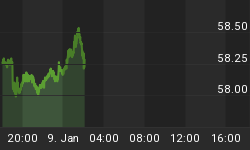The long and short of things - High beta currencies (Aussie) & commodities (Silver) have turned down - the Russell looks next:
-
The euro reversed sharply last week registering its largest decline since early July. The reversal took place subsequent to the largest drop in correlation (inverse) between the euro and the US dollar since the euro began electronic trading in 1999. Since the euro peaked in July 2008, these diminished correlation extremes have marketed exhaustion for the currency. We continue to view the US dollar index as primarily "caged" by the euro, as evident in the atypical correlation as well as the glaring divergence to the equal weighted US dollar index (FXCM) which just last week broke out to a two year high.
-
Although the Russell 2000 has recently achieved new all-time highs, over the intermediate to long-term - we favor large cap stocks over small and make the ratio (RUT:SPX) comparison to the downturn through 1997. Noteworthy, is the atypical positive relative strength divergence to the lower lows in the RUT:SPX ratio that is once again present as it was during the last secular turn. We also continue to follow the strong inverse correlation of the RUT:SPX ratio to the US dollar index that was present as well during the last turn. Considering the weekly RUT:SPX chart is at its divergent resistance, a sharp reversal in the ratio - as well as the equity markets appears imminent.
-
Silver and the silver:gold ratio contracted last week. The silver:gold ratio's performance spread to the SPX also contracted. We maintain a bearish perspective towards silver and the precious metals and feel another large leg lower is imminent. Should silver once again fail - we would expect it to be of the cascading variety below the lows of last year. Downstream, this could put the SPX in jeopardy of outperforming the silver:gold ratio (as measured from the start of the secular bear market in 2000); which in the past (2000 & 2007) has indicated the start of another cyclical leg lower in the equity markets. Conversely, should silver and silver:gold ratio bounce sharply - while the SPX corrects or underperforms on a relative basis, we would view that dynamic favorably towards the intermediate term in equities.
-
The SPX is once again pressured by the overhead resistance of the long-term (monthly) meridian. Since it broke through with Lehman Brothers in September 2008, the meridian has capped every subsequent advance. Despite the calls by many for a new secular bull market, we find no indications that it will be different this time around.
-
The Australian dollar further extended away from long-term resistance with net speculative long positions decreasing over the previous week - but remaining historically high. We continue to focus on the Aussie, considering its strong long-term correlation to the SPX as well as the precious metals market - specifically gold.
-
The Shanghai composite index was up modestly (0.55%) - while the CRB index was down (1.31%). Considering our outlook on the US dollar, we continue to maintain that the CRB will once again roll-over and break the lows from 2012.





































